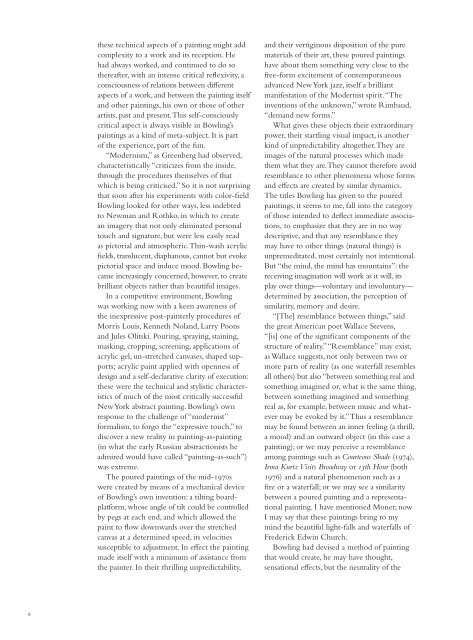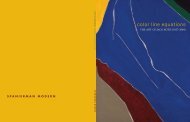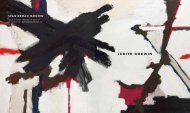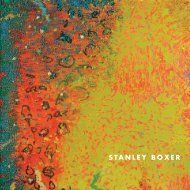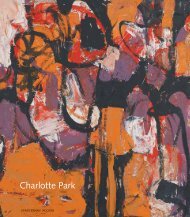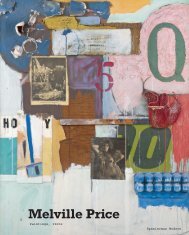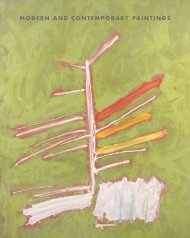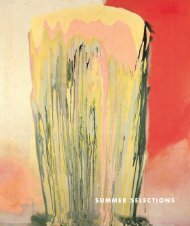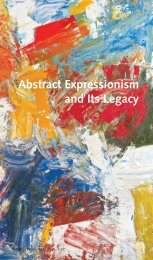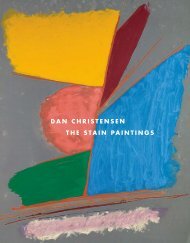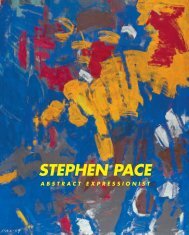View the catalogue - Spanierman Modern
View the catalogue - Spanierman Modern
View the catalogue - Spanierman Modern
Create successful ePaper yourself
Turn your PDF publications into a flip-book with our unique Google optimized e-Paper software.
<strong>the</strong>se technical aspects of a painting might add<br />
complexity to a work and its reception. He<br />
had always worked, and continued to do so<br />
<strong>the</strong>reafter, with an intense critical reflexivity, a<br />
consciousness of relations between different<br />
aspects of a work, and between <strong>the</strong> painting itself<br />
and o<strong>the</strong>r paintings, his own or those of o<strong>the</strong>r<br />
artists, past and present. This self-consciously<br />
critical aspect is always visible in Bowling’s<br />
paintings as a kind of meta-subject. It is part<br />
of <strong>the</strong> experience, part of <strong>the</strong> fun.<br />
“<strong>Modern</strong>ism,” as Greenberg had observed,<br />
characteristically “criticizes from <strong>the</strong> inside,<br />
through <strong>the</strong> procedures <strong>the</strong>mselves of that<br />
which is being criticised.” So it is not surprising<br />
that soon after his experiments with color-field<br />
Bowling looked for o<strong>the</strong>r ways, less indebted<br />
to Newman and Rothko, in which to create<br />
an imagery that not only eliminated personal<br />
touch and signature, but were less easily read<br />
as pictorial and atmospheric. Thin-wash acrylic<br />
fields, translucent, diaphanous, cannot but evoke<br />
pictorial space and induce mood. Bowling be -<br />
came increasingly concerned, however, to create<br />
brilliant objects ra<strong>the</strong>r than beautiful images.<br />
In a competitive environment, Bowling<br />
was working now with a keen awareness of<br />
<strong>the</strong> inexpressive post-painterly procedures of<br />
Morris Louis, Kenneth Noland, Larry Poons<br />
and Jules Olitski. Pouring, spraying, staining,<br />
masking, cropping, screening, applications of<br />
acrylic gel, un-stretched canvases, shaped supports;<br />
acrylic paint applied with openness of<br />
design and a self-declarative clarity of execution:<br />
<strong>the</strong>se were <strong>the</strong> technical and stylistic characteristics<br />
of much of <strong>the</strong> most critically successful<br />
New York abstract painting. Bowling’s own<br />
response to <strong>the</strong> challenge of “modernist”<br />
formalism, to forgo <strong>the</strong> “expressive touch,” to<br />
discover a new reality in painting-as-painting<br />
(in what <strong>the</strong> early Russian abstractionists he<br />
admired would have called “painting-as-such”)<br />
was extreme.<br />
The poured paintings of <strong>the</strong> mid-1970s<br />
were created by means of a mechanical device<br />
of Bowling’s own invention: a tilting boardplatform,<br />
whose angle of tilt could be controlled<br />
by pegs at each end, and which allowed <strong>the</strong><br />
paint to flow downwards over <strong>the</strong> stretched<br />
canvas at a determined speed, its velocities<br />
susceptible to adjustment. In effect <strong>the</strong> painting<br />
made itself with a minimum of assistance from<br />
<strong>the</strong> painter. In <strong>the</strong>ir thrilling unpredictability,<br />
and <strong>the</strong>ir vertiginous disposition of <strong>the</strong> pure<br />
materials of <strong>the</strong>ir art, <strong>the</strong>se poured paintings<br />
have about <strong>the</strong>m something very close to <strong>the</strong><br />
free-form excitement of contemporaneous<br />
advanced New York jazz, itself a brilliant<br />
manifestation of <strong>the</strong> <strong>Modern</strong>ist spirit. “The<br />
inventions of <strong>the</strong> unknown,” wrote Rimbaud,<br />
“demand new forms.”<br />
What gives <strong>the</strong>se objects <strong>the</strong>ir extraordinary<br />
power, <strong>the</strong>ir startling visual impact, is ano<strong>the</strong>r<br />
kind of unpredictability altoge<strong>the</strong>r. They are<br />
images of <strong>the</strong> natural processes which made<br />
<strong>the</strong>m what <strong>the</strong>y are. They cannot <strong>the</strong>refore avoid<br />
resemblance to o<strong>the</strong>r phenomena whose forms<br />
and effects are created by similar dynamics.<br />
The titles Bowling has given to <strong>the</strong> poured<br />
paintings, it seems to me, fall into <strong>the</strong> category<br />
of those intended to deflect immediate associations,<br />
to emphasize that <strong>the</strong>y are in no way<br />
descriptive, and that any resemblance <strong>the</strong>y<br />
may have to o<strong>the</strong>r things (natural things) is<br />
unpremeditated, most certainly not intentional.<br />
But “<strong>the</strong> mind, <strong>the</strong> mind has mountains”: <strong>the</strong><br />
receiving imagination will work as it will, its<br />
play over things—voluntary and involuntary—<br />
determined by association, <strong>the</strong> perception of<br />
similarity, memory and desire.<br />
“[The] resemblance between things,” said<br />
<strong>the</strong> great American poet Wallace Stevens,<br />
“[is] one of <strong>the</strong> significant components of <strong>the</strong><br />
structure of reality.” “Resemblance” may exist,<br />
as Wallace suggests, not only between two or<br />
more parts of reality (as one waterfall resembles<br />
all o<strong>the</strong>rs) but also “between something real and<br />
something imagined or, what is <strong>the</strong> same thing,<br />
between something imagined and something<br />
real as, for example, between music and whatever<br />
may be evoked by it.” Thus a resemblance<br />
may be found between an inner feeling (a thrill,<br />
a mood) and an outward object (in this case a<br />
painting); or we may perceive a resemblance<br />
among paintings such as Courteous Shade (1974),<br />
Irma Kurtz Visits Broadway or 13th Hour (both<br />
1976) and a natural phenomenon such as a<br />
fire or a waterfall; or we may see a similarity<br />
between a poured painting and a representational<br />
painting. I have mentioned Monet; now<br />
I may say that <strong>the</strong>se paintings bring to my<br />
mind <strong>the</strong> beautiful light-falls and waterfalls of<br />
Frederick Edwin Church.<br />
Bowling had devised a method of painting<br />
that would create, he may have thought,<br />
sensational effects, but <strong>the</strong> neutrality of <strong>the</strong><br />
6


